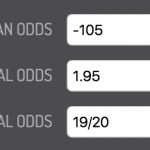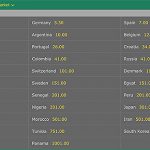Betting stake explained – what betting stakes are, how different staking systems work, and how you can manage your bankroll effectively. We’ll also examine the popular 1/10 to 10/10 stake system and what it means for your betting strategy.
Table of Contents
What is a Betting Stake?
Simply put, a betting stake is the amount of money you risk on a particular bet. For example, if you place a $20 bet on a basketball game in Velobet, your stake is $20. This stake represents the potential amount you stand to lose if your bet doesn’t win.
Betting stakes are crucial because they determine the level of risk you’re willing to take on each wager. Without proper stake management, even a few bad bets can drain your bankroll and leave you without funds to continue betting.

Why Betting Stakes Matter
Stakes are the backbone of responsible betting. They help control your risk, protect your bankroll, and ensure that you don’t overspend on bets that don’t offer good value.
Here’s why understanding and managing your stake is essential:
- Bankroll Protection: Without staking control, you risk losing your entire bankroll quickly, especially if you’re on a losing streak. Proper stake management helps protect your money.
- Long-Term Success: Betting isn’t just about the short-term. To stay profitable in the long run, you need to manage your risk and make calculated decisions about how much to bet on each wager.
- Risk Management: Betting is risky by nature, and managing stakes helps you control that risk. Larger bets carry more risk, while smaller bets allow you to absorb losses and stay in the game.
1/10 to 10/10 Betting Stake Explained
One popular way to manage your stakes is the 1/10 to 10/10 stake system. This system involves ranking your bets on a confidence scale from 1 to 10, with 1/10 being your smallest bet and 10/10 being your highest.
How it Works:
- 1/10 stake: This is the smallest amount you’re willing to risk, typically reserved for bets you’re least confident about. It represents 1 unit of your bankroll. For example, if your bankroll is $1,000 and your unit is $10, then a 1/10 stake would be $10. This is the stake to use when the odds are long, or you’re betting on a high-risk outcome.
- 5/10 stake: A 5/10 stake is a middle-ground bet, where you’re moderately confident in the outcome. It represents a more substantial portion of your bankroll, say 5 units. Using the same example, if your unit is $10, then a 5/10 stake would be $50.
- 10/10 stake: This is the highest level of confidence you can assign to a bet. A 10/10 stake represents the maximum amount you’re willing to risk on a bet, typically reserved for outcomes you feel very confident about. In this case, if your unit is $10, then a 10/10 stake would be $100.

Betting Stake Explained – Why to Use the 1/10 to 10/10 System?
The 1/10 to 10/10 stake system gives you flexibility in managing your risk depending on the perceived value or confidence of each bet. It allows you to allocate more of your bankroll to bets that you feel have a higher chance of winning, while keeping risk low on bets that are less certain.
Here’s a breakdown of what each level of staking might represent:
- 1/10 to 3/10 stakes: Low-confidence bets, often underdog bets or outcomes with very high odds. These are high-risk, low-certainty bets where a small stake is prudent.
- 4/10 to 6/10 stakes: Medium-confidence bets. These could be bets where the odds are fair, but there’s still some level of uncertainty, such as a game with evenly matched teams.
- 7/10 to 9/10 stakes: High-confidence bets. These are bets where you feel there’s a strong chance of success, such as when a favorite is likely to win, but the odds still offer value.
- 10/10 stake: Maximum-confidence bets. These are rare, and you should use them only when you are highly confident about the outcome, and the bet offers great value.
Example of the 1/10 to 10/10 Stake System
Let’s say you have a $1,000 bankroll, and you assign 1 unit as 1% of your bankroll, which equals $10.
- If you’re betting on a risky underdog that you think has a slim chance of winning but still worth a small wager, you might place a 1/10 stake or $10.
- If you’re betting on a matchup where you feel there’s a decent chance of success but still some uncertainty, like a game between two well-matched teams, you might assign a 5/10 stake, or $50.
- For a bet where you are highly confident about the outcome, such as a top team playing against a weaker opponent, you might assign a 9/10 stake, or $90.
This system helps you adjust your stake size based on how likely you think the bet is to succeed, ensuring that you’re not overexposing yourself on low-confidence wagers.
Different Types of Betting Stakes
Aside from the 1/10 to 10/10 system, there are other popular staking strategies that bettors use to manage their bankroll:
1. Fixed Betting Stake Explained
In the fixed stake strategy, you wager the same amount on every bet, regardless of the confidence level or odds. For example, you may decide to bet $20 on every wager.
- Pros: Simple to use and easy to maintain. It prevents emotional betting by keeping things consistent.
- Cons: Doesn’t allow for adjustments based on bet confidence or odds. You could be risking too much on a weak bet or not enough on a strong one.
2. Percentage of Bankroll Strategy
This system involves betting a fixed percentage of your current bankroll on each bet. For example, you might bet 2% of your total bankroll on every wager.
- Pros: Protects your bankroll by adjusting the stake size based on how much money you have left. If your bankroll shrinks, your bets shrink too.
- Cons: It can take longer to build your bankroll as your stakes may remain relatively small.
3. Kelly Criterion Betting Stake Explained
The Kelly Criterion is a more advanced system that calculates the optimal stake based on your perceived edge on the bet. The higher the value, the larger the stake, and vice versa.
- Pros: Maximizes long-term growth by only staking when you have an advantage.
- Cons: Requires accurate probability estimation, and small errors in calculating your edge can lead to poor staking decisions.
Bankroll Management Tips [Betting Stake Explained]
No matter which staking strategy you use, bankroll management is key to successful betting. Here are a few tips to keep in mind:
- Set a Budget: Only bet with money you can afford to lose. Set aside a specific bankroll and don’t exceed it.
- Stick to a Plan: Whether you use a fixed stake, percentage, or the 1/10 system, follow your plan. Avoid chasing losses by increasing your stakes when things aren’t going your way.
- Track Your Bets: Keep a record of your bets, stakes and outcomes. This will help you identify patterns and adjust your strategy if needed.
Betting Stake Explained Conclusion
Understanding and managing betting stakes is one of the most important factors in becoming a successful bettor. The 1/10 to 10/10 stake system offers a flexible and easy way to adjust your bet size based on your confidence level in each bet. We use it here for StakeHunters tips. Combined with proper bankroll management, it helps ensure that you can weather losing streaks and capitalize on winning ones without risking too much of your bankroll at any given time.
By adopting a disciplined staking plan, you’re not only protecting your money but also giving yourself the best chance to stay profitable in the long run.
Free tips, odds, the best tipsters and advices. Join us and be part of The StakeHunters Community!



